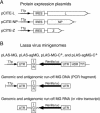Replicon system for Lassa virus
- PMID: 15564487
- PMCID: PMC533938
- DOI: 10.1128/JVI.78.24.13793-13803.2004
Replicon system for Lassa virus
Abstract
Lassa virus is endemic to West Africa and causes hemorrhagic fever in humans. To facilitate the functional analysis of this virus, a replicon system was developed based on Lassa virus strain AV. Genomic and antigenomic minigenomes (MG) were constructed consisting of the intergenic region of S RNA and a reporter gene (Renilla luciferase) in antisense orientation, flanked by the 5' and 3' untranslated regions of S RNA. MGs were expressed under the control of the T7 promoter. Nucleoprotein (NP), L protein, and Z protein were expressed from plasmids containing the T7 promoter and internal ribosomal entry site. Transfection of cells stably expressing T7 RNA polymerase (BSR T7/5) with MG in the form of DNA or RNA and plasmids for the expression of NP and L protein resulted in high levels of Renilla luciferase expression. The replicon system was optimized with respect to the ratio of the transfected constructs and by modifying the 5' end of the MG. Maximum activity was observed 24 to 36 h after transfection with a signal-to-noise ratio of 2 to 3 log units. Northern blot analysis provided evidence for replication and transcription of the MG. Z protein downregulated replicon activity close to background levels. Treatment with ribavirin and alpha interferon inhibited replicon activity, suggesting that both act on the level of RNA replication, transcription, or ribonucleoprotein assembly. In conclusion, this study describes the first replicon system for a highly pathogenic arenavirus. It is a tool for investigating the mechanisms of replication and transcription of Lassa virus and may facilitate the testing of antivirals outside a biosafety level 4 laboratory.
Figures









References
-
- Andrei, G., and E. De Clercq. 1990. Inhibitory effect of selected antiviral compounds on arenavirus replication in vitro. Antivir. Res. 14:287-299. - PubMed
-
- Auperin, D. D., D. R. Sasso, and J. B. McCormick. 1986. Nucleotide sequence of the glycoprotein gene and intergenic region of the Lassa virus S genome RNA. Virology 154:155-167. - PubMed
-
- Bausch, D. G., A. H. Demby, M. Coulibaly, J. Kanu, A. Goba, A. Bah, N. Conde, H. L. Wurtzel, K. F. Cavallaro, E. Lloyd, F. B. Baldet, S. D. Cisse, D. Fofona, I. K. Savane, R. T. Tolno, B. Mahy, K. D. Wagoner, T. G. Ksiazek, C. J. Peters, and P. E. Rollin. 2001. Lassa fever in Guinea. I. Epidemiology of human disease and clinical observations. Vector Borne Zoonotic Dis. 1:269-281. - PubMed
Publication types
MeSH terms
Substances
Associated data
- Actions
LinkOut - more resources
Full Text Sources
Other Literature Sources
Miscellaneous

